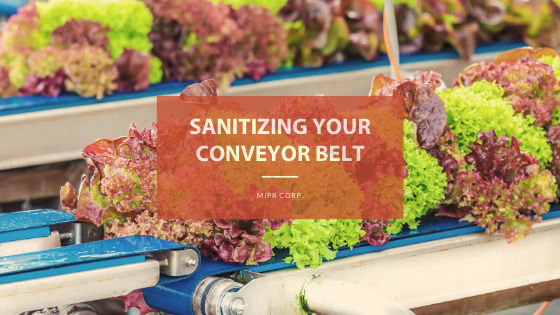
Despite the national slowdowns and lockdowns, many conveyor belts in critical applications are still running—and many more will be back online soon as different states and sectors of the economy reopen. It has never been more important to be sure that your conveyor belts are running clean. Slowing and stopping the transmission of COVID-19 is on everyone’s minds. From antimicrobial belts and food grade belting to powerful, practical advice on cleaning and sterilizing all belting types, the experienced engineering experts at MIPR Corp. are helping a wide range of industries step up their cleaning and sanitization protocols with conveyor belt safety tips to keep their staff and their customers safe.
When the Food Safety Modernization Act passed in 2011, our team worked closely with clients across the U.S. to ensure the compliance of their food conveyor belting. The products and techniques we developed to step up prevention efforts have added to our expertise in sanitary conveyor belting. If you have concerns, we have answers and solutions.
First and foremost, keeping sanitary conveyor belting on your production line means designing for easy, thorough, and frequent cleaning and regular conveyor belt maintenance. This means making sure all parts of your frames and belts are accessible—no nooks and crannies where food or germs can accumulate. (Frame-outs and belt lifters—which automatically separate the belt from the frame for cleaning—can be a big help here.) Avoiding horizontal surfaces where materials can pool is another way to improve sanitization—inclines encourage runoff, and proper use of catch pans can keep excess off the floor for proper disposal. Last but not least, ensuring all of your splices are smooth and completely sealed with no pinholes or bumps will also help prevent cross-contamination.
We are able to roll over and seal the belt edges. This eliminates fabric exposed edges and pressure washer cleaning damage, belt edges that last much longer.
Our engineers are always happy to evaluate your current production line to identify opportunities for improvement, so don’t hesitate to call and ask for a consultation.
Not sure how to clean a conveyor belt?
Our engineers recommend the following conveyor belt cleaning system:
- cleaning your frames from the center out whenever possible
- dry-cleaning to remove large, visible debris
- pre-rinsing before applying any detergent to clear out smaller particulates
- leaving detergents on belting and frames for 10-15 minutes to reach maximum effectiveness
- rinsing thoroughly, and using PH strips to test for detergent residue before sanitizing the belt
- ATP testing for bacteria after cleaning
- sanitizing carefully according to manufacture product instructions
- requiring staff to wear protective equipment (gloves, masks, eye protection) where indicated
- testing tracking before putting your belt back into service
- welded edges, no more strings hanging out
The type of belting you choose can also have an enormous impact on sanitary conditions on your production line:
ANTI-MICROBIAL AND FOOD GRADE BELTS
 From empty shelves at grocery stores to sweeping restaurant shutdowns, few areas of our economy have been hit harder by the coronavirus crisis than food service. We need safe, reliable food supply chains more than ever, and antimicrobial conveyor belting plays a key role in ensuring food preparation can keep moving forward.
From empty shelves at grocery stores to sweeping restaurant shutdowns, few areas of our economy have been hit harder by the coronavirus crisis than food service. We need safe, reliable food supply chains more than ever, and antimicrobial conveyor belting plays a key role in ensuring food preparation can keep moving forward.
FDA-approved antimicrobial conveyor belting can stand up to a wide range of temperatures and preparation techniques—high heat, flash freezing, cutting, shaping, molding, and more. Our newest anti-microbial, PURclean, is FDA-approved and ideal for the food industry and medical grade applications. It is no-fray, fabric wicking, easy to clean, fabricate, and field splice. In fact, for many products, it’s a quick and easy drop-in!
Sanitary belting strengthens your FDA food safety plan’s preventative controls. Think your bakery or food production line is too unique for a standard antimicrobial conveyor belt? Think again! MIPR Corp has created custom antimicrobial conveyor belting for over 40 years. From tortillas to ice cream, from meat and cheese to candy and sugar to breads and beers, our creative experts have successfully engineered safe and sanitary solutions that work.
FOOD-GRADE BELTING
 USDA-approved food grade belting is designed to stand up to intensive and rigorous cleaning and sanitizing, may feature special nonstick coatings to resist grease and oil, and can handle tough temperatures and procedures like baking, cooling, freezing, cutting, extrusion, molding, lamination, and more.
USDA-approved food grade belting is designed to stand up to intensive and rigorous cleaning and sanitizing, may feature special nonstick coatings to resist grease and oil, and can handle tough temperatures and procedures like baking, cooling, freezing, cutting, extrusion, molding, lamination, and more.
Our conveyor belt experts listen carefully to the details of your production line and can help you choose the perfect food grade belt to step up your sanitation. Our custom belt experts make sure you also get the right lacing and splicing techniques for maximum durability and safety.
MIPR stocks the complete range of food grade belting, from white food belting to metal mesh, plastic modular, Teflon, and glass—and we ship same-day samples nationwide.
If your business has slowed or stopped due to coronavirus closures, there has never been a better time to evaluate your conveyor belting and make much-needed changes. When you reopen, will you be working with less staff? Working faster to fulfill a big backlog? Working around new intensive cleaning and sanitization requirements? Our conveyor belting experts are on-call to help you meet any challenge that comes up during these uncertain times, from recommendations to replacements to repairs. We even ship samples same-day!




